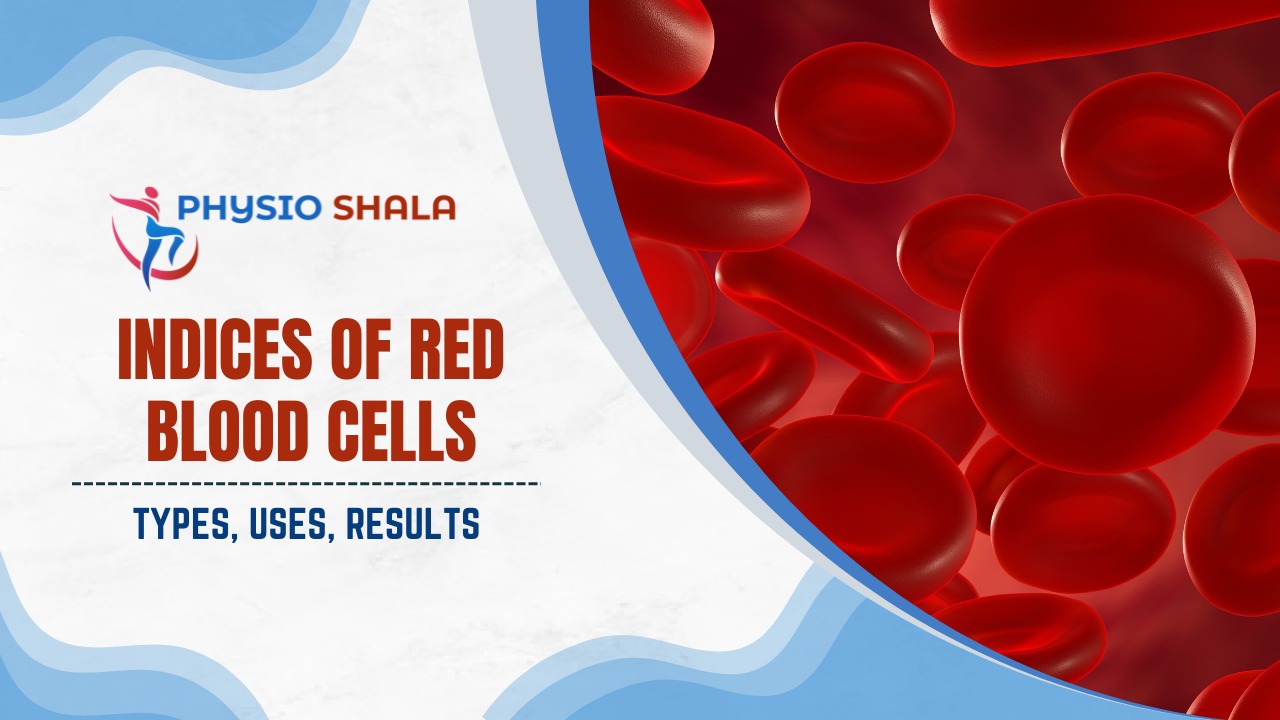Red Blood cells or erythrocytes are part of the cellular component of the blood. It contains hemoglobin (Hb) that turns red on binding with oxygen. Erythrocytes are responsible for carrying oxygen to the tissues from the lungs and carbon dioxide from tissues back to the lungs. Red blood cells also have certain antigens on their surface that determine the blood group of an individual.
Morphological Features of Red Blood Cells
Shape– RBCs are circular and shaped like a biconcave disc
Advantages of biconcave disc shape:
- Greater surface area/volume ratio
- it allows for considerable alteration in cell volume. Thus, it can withstand changes of osmotic pressure and in turn resist hemolysis.
- Provides flexibility to the cell so that it can easily pass through narrow capillaries.
- Haemoglobin remains distributed in the center of the RBC which facilitates the optimal and quick exchange of gases.
Structure– It is non-nucleated or anucleate
- – It contains a red-colored pigment- Haemoglobin
- – No organelle is there
- – Central pallor is seen due to less hemoglobin in the center.
Size – Diameter: 7-7.8 µm,
Thickness at the periphery-2.2 µm and
Centre – 1 µm
Normal Values of Red Blood Cells
- Normal RBC count at birth- 6-7 million/µL/cubic millimetres
- Normal RBC count in adults-
- Males: 5-6 million/µL/cubic millimeters
- Females: 4.5-5.5 million/µL/cubic millimetres
- Hb content-14-16 gm/dl
- Oxygen carrying Capacity of blood-1 gm Hb binds to 1.34 ml of O2
- Packed Cell Volume (PCV) =45±2 ml/100 ml of blood
- The life span of RBCs- 120 days
Hematological Indices of Red Blood Cells
Blood is comprised of two components, namely- plasma and cells. The cellular part consists of red blood cells/erythrocytes, white blood cells/leukocytes, and platelets/thrombocytes. RBC indices are the components of a test called complete blood count or CBC.
All the RBCs in the blood are normally of the same size, shape, and color, but some conditions may cause alterations in these specifics. The CBC test helps to determine the condition of individual cellular components in the blood.
It also becomes important in cases of anemia in which case CBC or blood indices are required to determine if the RBCs have normal morphological characters and normal hemoglobin levels. Abnormal values of blood indices indicate the presence and the type of anemia.
Mean Corpuscular Haemoglobin (MCH)
MCH is defined as the average hemoglobin content/mass present in a single red blood cell. The result is expressed in picograms (pg).
It is calculated as follows:
Normal Range– 27-32 picograms per cell
Example:
Given: Hb= 15g%; RBC count= 5 million/mm3
MCH= 15 x 10 ÷ 5= 30 picograms per cell
Mean Corpuscular Volume (MCV)
MCV is defined as the average volume of a single red blood cell expressed in cubic micrometers. It measures the average size of a single RBC and is obtained by dividing the hematocrit by the complete RBC count.
It is calculated as follows:
Normal Range– 74-95 cubic micrometres
Example:
Given: PCV= 45%; RBC count= 5 million/mm3
MCV= 45 x 10 ÷ 5 = 90µ3
Interpretation:
- MCV in the normal range- Normocytic RBC i.e., normal size
A patient suffering from acute haemorrhage will have normocytic anemia.
- MCV more than the normal range- Macrocytic RBC i.e., larger size than normal
Causes: pernicious anemia, folic acid deficiencies, deficiency in maturation factors
- MCV lower than normal range- Microcytic RBC i.e., smaller size than normal
Causes: iron deficiency, lead poisoning, genetic diseases- thalassemia major and thalassemia minor
Mean Corpuscular Haemoglobin Concentration (MCHC)
MCHC represents the relationship between the red blood cell volume and its percentage saturation with hemoglobin in other words it measures the proportion of each cell taken up by hemoglobin.
It does not take into account the total RBC count and is expressed in percentage.
It is calculated as follows:
Normal Range– 30-36%
Example:
Given: Hb= 15%; PCV= 45%
MCHC= (15 ÷ 45) × 100 = 33.33%
Interpretation:
- MCHC in Normal range- Normochromic cells (Normal hemoglobin concentration)
- MCHC less than normal- Hypochromic cells (RBC deficient in hemoglobin concentration)
MCHC can not be more than normal as erythrocytes cannot be filled with hemoglobin beyond a certain limit. If the cell size increases the hemoglobin content will be more but the concentration will not be.
Morphological Types of Anaemia
- Normocytic Normochromic Anaemia
- Normal values of MCH, MCV, and MCHC
- Occurs in cases of acute hemorrhage
- Microcytic Hypochromic Anaemia
- Reduced MCH, MCV, and MCHC
- Most commonly seen in iron deficiency
- Macrocytic Normochromic Anaemia
- Increased MCV, Variable MCH, and MCHC
- Occurs in vitamin-B12 and folic acid deficiencies
References –

